Bolivia, Brazil, Ecuador and Peru
Item set
- Título / Título / Título
- Bolivia, Brazil, Ecuador and Peru
Items
-
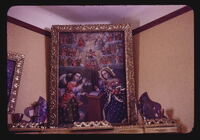 Unknown Title Colonial Painting. Bolivia.
Unknown Title Colonial Painting. Bolivia. -
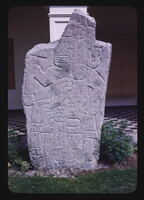 Another relief carving of a human figure from Sechin. Another relief carving of a human figure from Sechin.
Another relief carving of a human figure from Sechin. Another relief carving of a human figure from Sechin. -
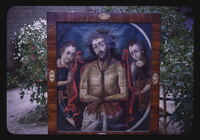 Unknown Title Colonial Painting. Bolivia.
Unknown Title Colonial Painting. Bolivia. -
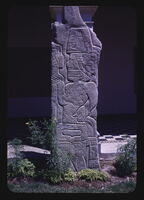 Carved relief monolith from the Temple of Sechin in the Casma valley. Carved relief monolith from the Temple of Sechin in the Casma valley. This figure is characteristic of the Sechin style, a style which has not yet been placed chronologically in the sequence of ancient Peruvian cultural development, but which bears some resemblances to Chavin.
Carved relief monolith from the Temple of Sechin in the Casma valley. Carved relief monolith from the Temple of Sechin in the Casma valley. This figure is characteristic of the Sechin style, a style which has not yet been placed chronologically in the sequence of ancient Peruvian cultural development, but which bears some resemblances to Chavin. -
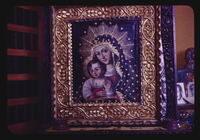 Unknown Title Colonial Painting. Bolivia.
Unknown Title Colonial Painting. Bolivia. -
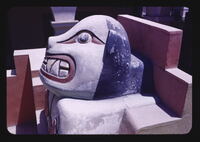 Reconstructed Temple. Detail of Jaguar Head. Reconstructed Temple. Detail of Jaguar Head.
Reconstructed Temple. Detail of Jaguar Head. Reconstructed Temple. Detail of Jaguar Head. -
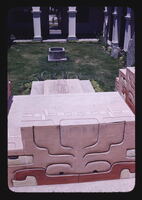 Reconstructed Temple. Detail of Decoration. Reconstructed Temple. Detail of Decoration.
Reconstructed Temple. Detail of Decoration. Reconstructed Temple. Detail of Decoration. -
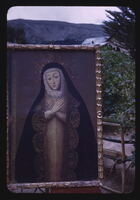 Unknown Title Colonial Painting. Bolivia.
Unknown Title Colonial Painting. Bolivia. -
 Reconstructed Temple. Detail of Decoration. Reconstructed Temple. Detail of Decoration.
Reconstructed Temple. Detail of Decoration. Reconstructed Temple. Detail of Decoration. -
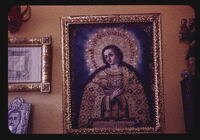 Unknown Title Colonial Painting. Bolivia.
Unknown Title Colonial Painting. Bolivia. -
 Another view of the reconstructed temple Another view of the reconstructed temple
Another view of the reconstructed temple Another view of the reconstructed temple -
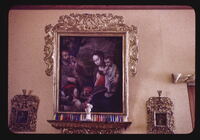 Unknown Title Colonial Painting. Bolivia.
Unknown Title Colonial Painting. Bolivia. -
 Unknown Title Bolivia
Unknown Title Bolivia -
 Detail of the reconstructed temple. Detail of the reconstructed temple.
Detail of the reconstructed temple. Detail of the reconstructed temple. -
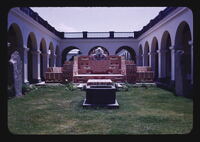 A replica of a Chavin period temple placed in the central court of the museum A replica of a Chavin period temple placed in the central court of the museum. This reconstruction is based on the temples of Cerro Blanco and Punguri, excavated in the Nepena valley.
A replica of a Chavin period temple placed in the central court of the museum A replica of a Chavin period temple placed in the central court of the museum. This reconstruction is based on the temples of Cerro Blanco and Punguri, excavated in the Nepena valley. -
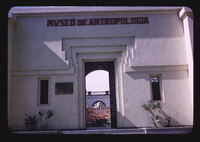 View through the Main Entrance of the National Museum of Anthropology and Archaeology View through the main entrance, showing a section of the restored coastal Chavin Temple in the background
View through the Main Entrance of the National Museum of Anthropology and Archaeology View through the main entrance, showing a section of the restored coastal Chavin Temple in the background -
 General View of the Facade of the National Museum of Anthropology and Archaeology General View of the Facade
General View of the Facade of the National Museum of Anthropology and Archaeology General View of the Facade -
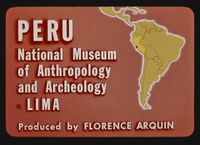 Title Slide - Peru, National Museum of Anthropology and Archaeology, Lima Peru, Preconquest Indian Cultures from the National Museum of Anthropology and Archaeology Magdalena la Vieja
Title Slide - Peru, National Museum of Anthropology and Archaeology, Lima Peru, Preconquest Indian Cultures from the National Museum of Anthropology and Archaeology Magdalena la Vieja -
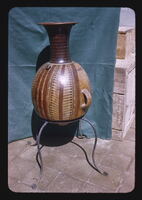 Pottery Aryballus. Classic Inca of Cuzco Style. Pottery Aryballus. Classic Inca of Cuzco Style.
Pottery Aryballus. Classic Inca of Cuzco Style. Pottery Aryballus. Classic Inca of Cuzco Style. -
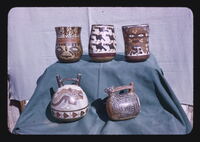 Pottery, Nazca Culture. Pottery. Nazca culture (from the south coast of Peru 500-1000 AD). This pottery is outstanding for the use of positive color.
Pottery, Nazca Culture. Pottery. Nazca culture (from the south coast of Peru 500-1000 AD). This pottery is outstanding for the use of positive color. -
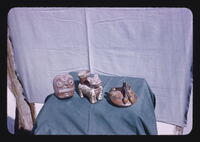 Three Pottery Vessels, Tiahuanaco. Three Pottery Vessels. The effigy vessels at the left and center are of the coast Tiahuanaco style. The vessel at right appears to belong to the north coast Tiahuanaco period.
Three Pottery Vessels, Tiahuanaco. Three Pottery Vessels. The effigy vessels at the left and center are of the coast Tiahuanaco style. The vessel at right appears to belong to the north coast Tiahuanaco period. -
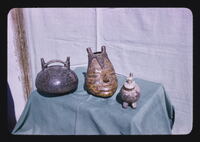 Pottery. Paracas (Cavernas) style from south coast of Peru Pottery. Paracas (Cavernas) style from south coast of Peru (circa 500 BC), decorated by incision, modeling, and painting. Much of the paint of the Paracas (Cavernas) pottery appears to have been applied without firing.
Pottery. Paracas (Cavernas) style from south coast of Peru Pottery. Paracas (Cavernas) style from south coast of Peru (circa 500 BC), decorated by incision, modeling, and painting. Much of the paint of the Paracas (Cavernas) pottery appears to have been applied without firing. -
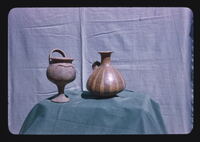 Pottery Vessels, Inca Style, probably made on the north coast. Pottery Vessels, Inca Style, probably made on the north coast.
Pottery Vessels, Inca Style, probably made on the north coast. Pottery Vessels, Inca Style, probably made on the north coast. -
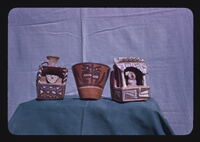 Three Pottery Vessels. North Coast Tiahuanaco (1000 - 1250 A.D.). Three Pottery Vessels. North Coast Tiahuanaco (1000 - 1250 A.D.).
Three Pottery Vessels. North Coast Tiahuanaco (1000 - 1250 A.D.). Three Pottery Vessels. North Coast Tiahuanaco (1000 - 1250 A.D.). -
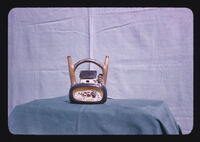 Pottery Vessel decorated with modeled house, animals, and people (front view of no. 66). North coast Tiahuanaco. Pottery Vessel decorated with modeled house, animals, and people (front view of no. 66). North coast Tiahuanaco.
Pottery Vessel decorated with modeled house, animals, and people (front view of no. 66). North coast Tiahuanaco. Pottery Vessel decorated with modeled house, animals, and people (front view of no. 66). North coast Tiahuanaco. -
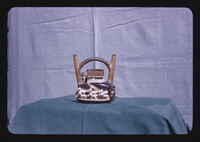 Pottery Vessel decorated with modeled house, animals, and people. North Coast Tiahuanaco. Pottery Vessel decorated with modeled house, animals, and people. North coast Tiahuanaco (rear view).
Pottery Vessel decorated with modeled house, animals, and people. North Coast Tiahuanaco. Pottery Vessel decorated with modeled house, animals, and people. North coast Tiahuanaco (rear view). -
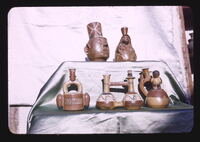 Inca Pottery, North Coast Inca Pottery, North Coast (1480-1530)
Inca Pottery, North Coast Inca Pottery, North Coast (1480-1530) -
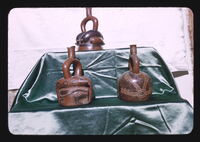 Pottery Vessels, Cupisnique Period. Pottery Vessels, Cupisnique period, showing decoration by combined incision, modeling, and red and black painting
Pottery Vessels, Cupisnique Period. Pottery Vessels, Cupisnique period, showing decoration by combined incision, modeling, and red and black painting -
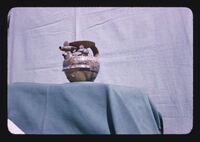 Typical Recuay modeled pottery jar. Typical Recuay modeled pottery jar.
Typical Recuay modeled pottery jar. Typical Recuay modeled pottery jar. -
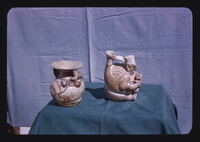 Pottery vessels showing a blend of Mochica and Recuay influences Pottery vessels showing a blend of Mochica and Recuay influences
Pottery vessels showing a blend of Mochica and Recuay influences Pottery vessels showing a blend of Mochica and Recuay influences -
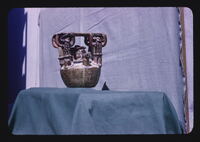 Pottery Vessel decorated with four servants holding a sun shade over a seated Dignitary, Recuay. Pottery Vessel decorated with modeled figures of four servants holding a sun shade over a seated dignitary and painted in both negative and positive techniques. Recuay (this culture centers in the Callejon de Huaylas and is approximately contemporaneous with Mochica)
Pottery Vessel decorated with four servants holding a sun shade over a seated Dignitary, Recuay. Pottery Vessel decorated with modeled figures of four servants holding a sun shade over a seated dignitary and painted in both negative and positive techniques. Recuay (this culture centers in the Callejon de Huaylas and is approximately contemporaneous with Mochica) -
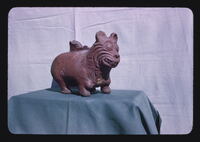 Pottery Effigy Jar, probably from the Gallinazo Period Pottery Effigy Jar, probably from the Gallinazo Period
Pottery Effigy Jar, probably from the Gallinazo Period Pottery Effigy Jar, probably from the Gallinazo Period -
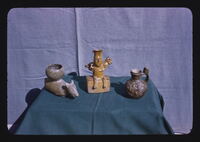 Effigy Pottery of the Spanish Colonial Period. Effigy Pottery of the Spanish Colonial Period, which shows the continuation of the native Chimu traditions.
Effigy Pottery of the Spanish Colonial Period. Effigy Pottery of the Spanish Colonial Period, which shows the continuation of the native Chimu traditions. -
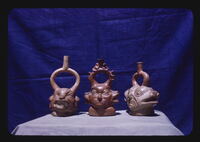 Pottery Stirrup Vessels with Four Faces. Pottery Stirrup Vessels with four faces; animals and anthropomorphic.
Pottery Stirrup Vessels with Four Faces. Pottery Stirrup Vessels with four faces; animals and anthropomorphic. -
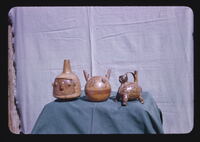 Pottery, Early Lima Style Pottery, Early Lima Style (central coast, 500-1000 A.D.).
Pottery, Early Lima Style Pottery, Early Lima Style (central coast, 500-1000 A.D.). -
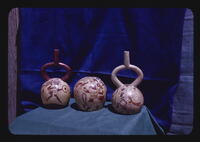 Painted Vessels showing Warrior scenes, Mochica Period. Painted Vessels showing Warrior scenes, Mochica Period.
Painted Vessels showing Warrior scenes, Mochica Period. Painted Vessels showing Warrior scenes, Mochica Period. -
 Pottery Vessels in the of Fish, Crab, and Frog Effigy Figures; Mochica Period Pottery vessels in the form of fish, crab, and frog effigy figures; Mochica Period.
Pottery Vessels in the of Fish, Crab, and Frog Effigy Figures; Mochica Period Pottery vessels in the form of fish, crab, and frog effigy figures; Mochica Period. -
 Pottery Water Jars, Mochica Period. Pottery water jars in the form of bird and animal effigy figures, Mochica Period.
Pottery Water Jars, Mochica Period. Pottery water jars in the form of bird and animal effigy figures, Mochica Period. -
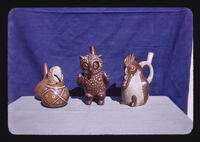 Pottery Vessels in the form of Birds. Mochica Period Pottery Vessels in the form of Birds. Mochica Period
Pottery Vessels in the form of Birds. Mochica Period Pottery Vessels in the form of Birds. Mochica Period -
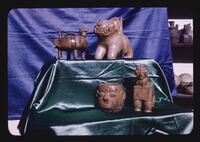 Pottery, Gallinazo Period. Pottery, Gallinazo period (north coast, 200-700 AD); painted decoration by negative or batik process (resist dye painting).
Pottery, Gallinazo Period. Pottery, Gallinazo period (north coast, 200-700 AD); painted decoration by negative or batik process (resist dye painting).